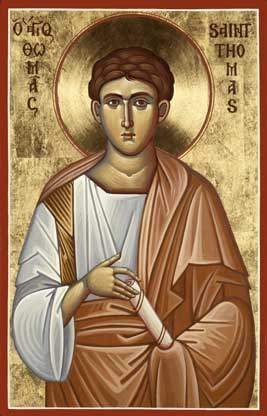
Today is the feast day of Saint Thomas the Apostle. For most anyone who was raised on Bible stories, including myself, the most memorable thing about St. Thomas is his skepticism at Jesus’s Resurrection. Indeed, the figure of “Doubting Thomas” has entered our cultural parlance.
Now Thomas, one of the Twelve, called the Twin, was not with them when Jesus came. So the other disciples told him, “We have seen the Lord.” But he said to them, “Unless I see in his hands the mark of the nails, and place my finger into the mark of the nails, and place my hand into his side, I will never believe.” (John 20:24-29)
Eight days later, his disciples were inside again, and Thomas was with them. Although the doors were locked, Jesus came and stood among them and said, “Peace be with you.” Then he said to Thomas, “Put your finger here, and see my hands; and put out your hand, and place it in my side. Do not disbelieve, but believe.” Thomas answered him, “My Lord and my God!” Jesus said to him, “Have you believed because you have seen me? Blessed are those who have not seen and yet have believed.”
In one sense, Thomas represents the burden of the intellectual: the doubt that comes from thinking and questioning; the demand of the rational mind for concrete, tangible proof. My middle name is Thomas. Growing up, questioning my faith, struggling with doubts, I always felt a lot of affinity for St. Thomas. There were so many times when I longed for a sign, to touch the wounds of Jesus; to see and know.
It’s very easy to imagine Thomas as the snotty, intellectual skeptic, demanding a sign. But I get a different sense of Thomas. Except for the “Doubting Thomas” episode, he is a marginal figure in the Gospels; he is only mentioned in the rosters of the Twelve by the Evangelists Matthew, Mark, and Luke. But John’s is a Gospel that seeks to capture the deep sentiments of the spirit and heart. For John, Thomas’s doubt and confession is a moving, emotional moment; a time for Jesus Himself to speak to the doubts of all of us “who have not seen and yet have believed.” At two other times, John gave Thomas the spotlight:
Then after this he said to the disciples, “Let us go to Judea again.” The disciples said to him, “Rabbi, the Jews were just now seeking to stone you, and are you going there again?” . . .
Then Jesus told them plainly, “Lazarus has died, and for your sake I am glad that I was not there, so that you may believe. But let us go to him.” So Thomas, called the Twin, said to his fellow disciples, “Let us also go, that we may die with him.” (John 11:6-16)
This might appear, at first glance, to be a cynical, pessimistic comment: “Lazarus is dead; we’re all going to die, too, if we go back there.” But if we take Thomas’s “him” to refer to Jesus, not Lazarus, this is a statement of bold courage: “We will follow you even unto death.” This is the way the Fathers interpreted it. In this case, rather, Thomas appears to be passionate, emotional, even brash.
The other time John mentioned Thomas, at the Last Supper, he is Jesus’s interlocutor for one of His most important statements:
“And if I go and prepare a place for you, I will come again and will take you to myself, that where I am you may be also. And you know the way to where I am going.” Thomas said to him, “Lord, we do not know where you are going. How can we know the way?” Jesus said to him, “I am the way, and the truth, and the life. No one comes to the Father except through me. If you had known me, you would have known my Father also. From now on you do know him and have seen him.” (John 14:1-7)
None of the Twelve really understood what Jesus was talking about. Despite his confusion, Thomas seems prepared to go anywhere Jesus asks.
The sense I get of Thomas, overall, is not the hard-nosed skeptic, but the passionate, devoted follower, deeply feeling, but like Peter, of so “little faith.” He was ready to follow Jesus to the ends of the earth, to give his all — but at Jesus’s death, he was shattered: all the hopes and dreams he had for the coming kingdom crushed. Dejected and depressed, he wandered away; he was not even hanging out with the other disciples when the resurrected Jesus first appeared. When he heard the news, he no doubt thought the companions delusional. His doubt was deeply rooted in disappointment and loss. How could he bring himself to believe again?
But he touched Jesus’s wounds: and he was transformed. “My Lord and my God!” All his doubt, not just about Jesus’s reality, but about His lordship and His divinity, melted away in an instant. Thomas’s redemption is as dramatic as the reinstatement of Peter.

And from that moment on, Thomas’s faith was unshakable. As someone who has doubted in my life, I find Thomas’s example particularly inspiring: because he went from doubting, from not even believing Jesus could rise again, to being so thoroughly convinced that he really did go to the ends of the earth. Tradition holds that Thomas covered more distance than any other Apostle, going as far as India, some 3,000 miles from Jerusalem, where he won a martyr’s crown. He is perhaps the only Apostle to have ministered beyond the bounds of the Roman Empire. The Saint Thomas Christians, or Nasrani, are believed to be the fruits of his apostolic labor.
Additional links:
- St. Thomas Church, Palayur – One of the seven churches St. Thomas is believed to have founded in A.D. 52, part of the Syro-Malabar Catholic Church, in full communion with Rome.
- St. Mary’s Orthodox Syrian Church, Niranam — Another of the churches held to have been founded by St. Thomas, part of the Syrian Orthodox Church.
- Kottakkavu St. Thomas Church, Kerala — A photograph of another of the St. Thomas churches. These three are the only ones that have remained in their original locations.
- St. Thomas the Apostle at Catholic Encyclopedia
- St. Thomas the Apostle at uCatholic
- St. Thomas the Apostle at Saints.SQPN.com
I think St. Thomas gets a bad rap sometimes that’s unfair….the other apostles weren’t rushing to believe the women when they said they’d seen Christ alive either. But then….it’s possible that St. Thomas was not present when Christ appeared to the others because he had fallen that much more away from the group. In any case, the fact that his doubting brought about the situation where he was literally offered Christ’s wounds to touch is so important in showing that Christ’s crucifixion and resurrection were literal events – the crucifixion was not an illusion, as the Muslims say, nor was the resurrection symbolic, as the Baha’is say. This passage was key to my own conversion. I’m sure I’m not the only one who owes this much to St. Thomas!
Thanks for the comment! I know I owe him a lot, and I think many other people do too. He is the perfect example to illustrate not only the truth of the Resurrection, but the fact that it was a corporeal, tangible Resurrection. Some of the early heresies had similar thoughts to those you mention. The Docetists, for example, thought Jesus was a phantasm his whole life, and only appeared to be human — which means he couldn’t have really been crucified, couldn’t really have died, couldn’t have been resurrected… the Evangelists wanted to remove all doubt.
There you are again! I didn’t realize this was your blog. Nice blog 🙂
Great post! Thomas offers us all a friend in the sense that many of us have had doubts, and we are somehow licensed by Thomas, because the Lord knows we need a sign, but tells us it is better to have simple faith. That’s a lesson I appreciate a lot, especially at the moment. HAPPY 4 JULY 🙂
I love Thomas! I got to preach on him a couple months ago, and the closer I read the story of “Doubting Thomas”, the more I began to laugh. The whole story repeats itself: the women tell the disciples about Jesus’ resurrection and they don’t believe. Then Jesus appears to them and SHOWS THEM his wounds, which makes them believe. So when they all go to Thomas and, surprise, he doesn’t believe (just like they didn’t), I start to laugh because it starts all over again! Thomas doesn’t believe the words of his friends and has to get the EXACT same evidence that the other disciples did in order to believe.
And his other appearances in John definitely hint that there was more to this man than just doubt–he was extraordinary in his willingness to follow Jesus.
Thomas has always been one of my favorites, too. I’d never thought about the story that way before — but you’re right, it’s pretty funny. 🙂
I’m loving all this Thomas-love!
I agree, I think St Thomas was definitely the passionate sort. He was either all in or all out. When he doubted, he really doubted. When he believed, he *really* believed. (I also like your point about why Thomas wasn’t with the other disciples, I’d never thought about that!)
And thanks for your comments over at my new blog! I’ve been enjoying reading your posts quietly for some time so this is exciting!
Thank you. 🙂 I’m glad to meet you. Please don’t be shy, and comment from now on!